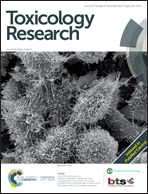Eco-friendly synthesis of glutathione-capped CdTe/CdSe/ZnSe core/double shell quantum dots: their cytotoxicity and genotoxicity effects on Chinese hamster ovary cells
Abstract
In this work, we report green one-pot synthesis, cytotoxicity and genotoxicity of glutathione-capped CdTe/CdSe/ZnSe heterostructured quantum dots (QDs) using a label-free xCELLigence RTCA system as well as the Cytokinesis Blocked Micronucleus assay. The as-synthesised nanocrystals displayed good optical properties and were spherical in shape with an average particle diameter of 5.9 ± 1.13 nm. The intracellular uptake study showed that most of the as-synthesised glutathione stabilized QDs penetrated the cell membranes and were found randomly localized in the cytoplasm of Chinese Hamster Ovary (CHO) cells even at a lower concentration of 0.5 μg ml−1. The QDs showed no cytotoxicity to Chinese Hamster Ovary (CHO) cells at six concentrations tested (0.5, 1.0, 2.5, 5.0, 10, and 25 μg ml−1). However, at 50 and 100 μg ml−1 the material was cytotoxic at significant p values of 3.1 × 10−4 and 9.47 × 10−10, respectively. Likewise, the material was found to be genotoxic at almost all concentrations tested. The genotoxicity of the nanocrystals in question confers unfavorable potential to all complex heterostructured nanocrystals. Hence, more studies are needed to negate the prevailing assumption that multishell passivation provides enough protection against intracellular QD core dissolution or the production of reactive oxygen species (ROS) before these nanomaterials can be used in vivo for human health applications.



 Please wait while we load your content...
Please wait while we load your content...